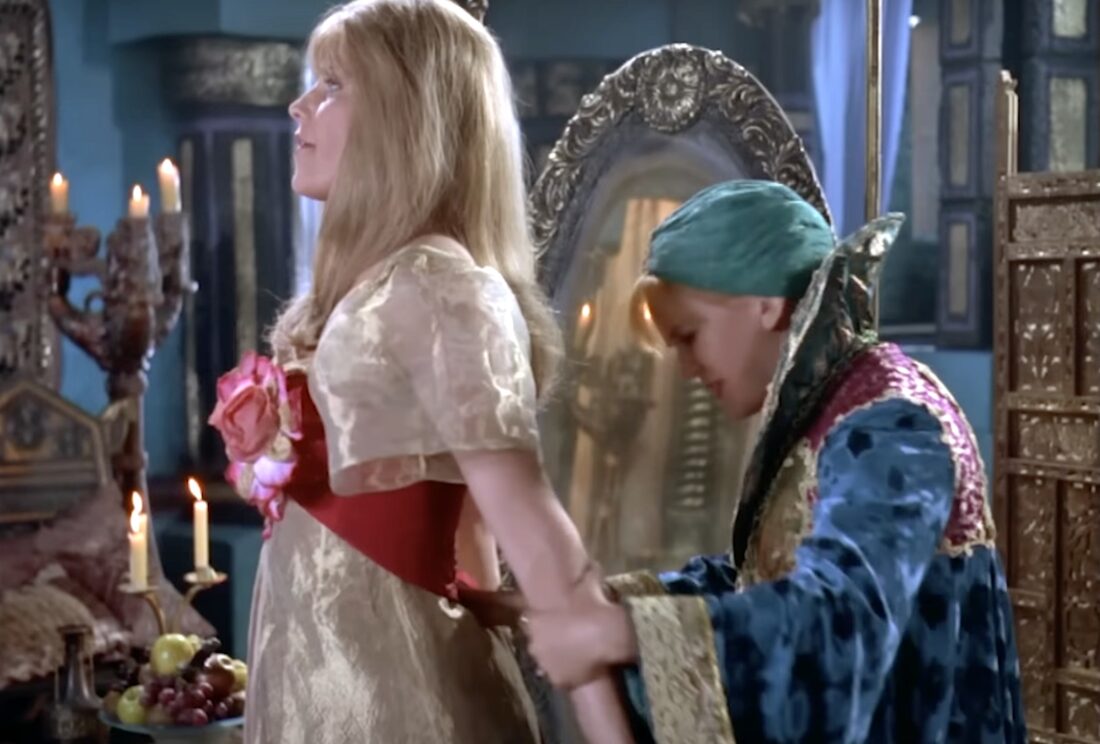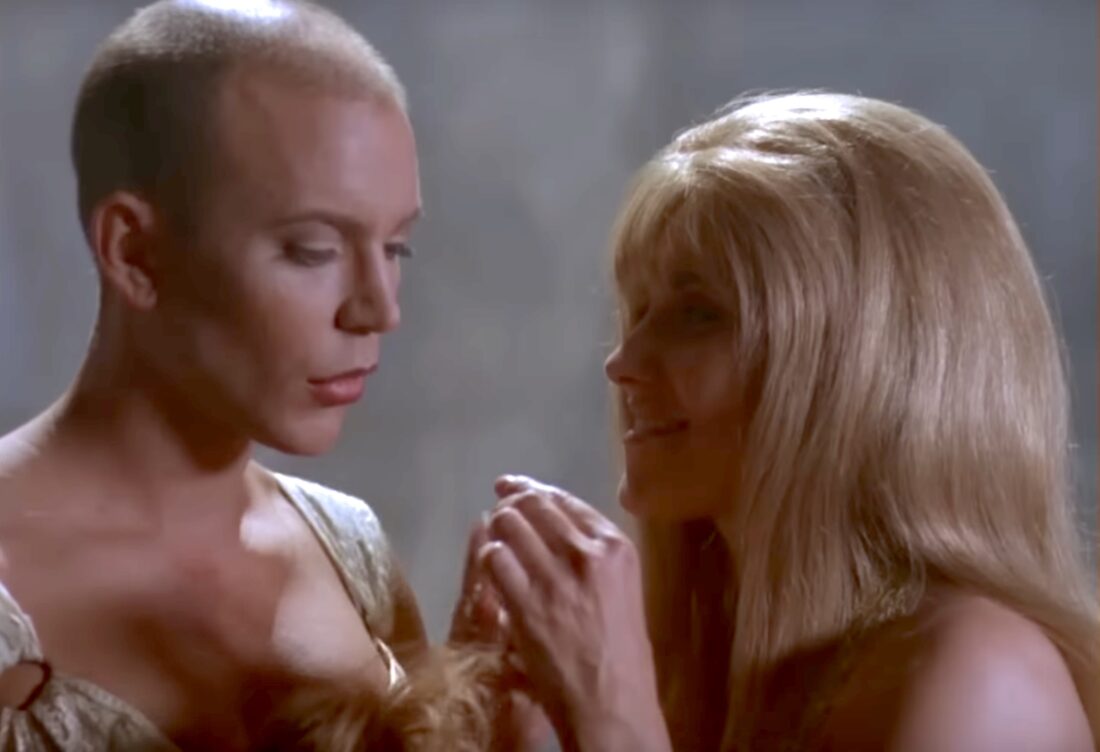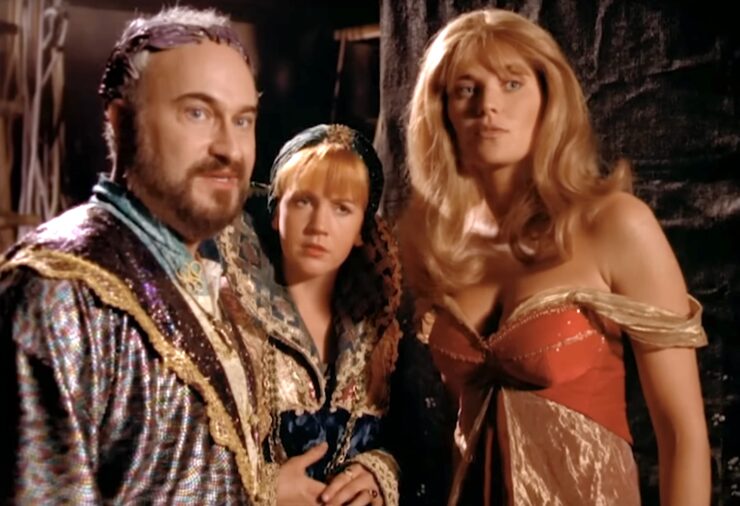No offense to the absolutely fabulous performers death-dropping everywhere from local bars to the world’s largest stages right now, but one drag queen reigned first. All hail Miss Artiphys, the breakout star of a 1997 episode of Xena: Warrior Princess called “Here She Comes… Miss Amphipolis.” A character with wit, warmth, and humor—played by an actual queer person living with AIDS. And for a show where Greek gods regularly drop in from Olympus to mess with characters, maybe the most fantastical aspect of the episode is that there’s no tragic ending for Miss Amphipolis, who actually takes the crown in a beauty pageant. The only killing? When characters slay campy lines.
I’ve been re-watching Xena, now an out adult and not a closeted teen catching episodes with my parents when the show first aired. And by the gods, does this episode have it all. Feminist skewerings of a beauty pageant. Wigs. Musical numbers. Fake accents. All leading up to one extravaganza of a scene when someone accuses Miss Artiphys, wearing Xena’s stolen armor, of being the warrior princess. And Miss Artiphys retorts, “Honey, I’m no princess. I’m a queen!”
In a show that often gleefully slips into comedy as two bisexual warrior partners—their relationship dancing between subtext to chakram-in-the-face text over the course of the show’s seven seasons—travel the world fighting evil, this episode basically takes the crown in the category of camp perfection. And I can’t believe it aired in 1997.
“Stand back, and let her through. She’s the one girl who’ll do,” Salmoneous sings as Miss Artiphys takes her victory stroll down the stage. “A beauty so mythic, her figure’s terrific. She’s Miss Known World.”

The plot of the episode, written by Chris Manheim sure feels familiar to fans of the 2000 Sandra Bullock film Miss Congeniality (guilty as charged), with a thin pretense to get our subversive feminist hero into a beauty contest. Which feels to her so against everything she stands for. Xena (Lucy Lawless, queen in whatever she does especially the existential cylon D’Anna Biers in the re-imagined Battlestar Galactica) and Gabrielle (ray of sunshine Renée O’Connor) receive a message from occasionally shady businessman and friend Salmoneous (recurring guest star Robert Trebor). He’s hosting a beauty pageant and needs their help.
Xena snaps, “You sent urgent word for us to come and see some underdressed, over-developed bimbos in a beauty contest?” And I just love that that barb is coming from someone in a leather breastplate. Gabrielle, too, calls the pageant “a feeble excuse for men to exploit and degrade women.” Wrong, Salmoneous tells them, the pageant is all about keeping peace. A year ago, three area leaders signed a treaty to end years of bloodshed, and the pageant is a way of celebrating the anniversary. The leaders have each sponsored one contestant in the Miss Known World pageant—genius name, by the way—but now someone is messing with things. Destroying costumes, wrecking props, even trying to abduct contestants during practice. The lives of the contestants are in danger as they’re being used to “wage a war by proxy,” Xena observes. The only chance of keeping the peace is for the pageant to go off without a hitch. So what’s a warrior princess to do? Enter the contest herself, naturally, to watch things from the inside, keep the contestants safe, and get to the bottom of the sabotage.
Once Xena and Gabrielle arrive at a palace, the location of the pageant, Xena adopts the airhead persona of Miss Amphipolis, while Gabrielle pretends to be her sponsor, the Marquesa (with O’Connor hamming it up with an overwrought French accent), and investigates how the male leaders are jerks who think the success of the contestants they’ve entered in the competition is all about them. Throughout the day, Xena befriends fellow contestants Miss Messini (Simone Kessell), Miss Parnassus (Jennifer Rucker), and Miss Skiros (Katherine Kennard) and learns why each are in the competition. All for noble means, of course, like winning extra food for their once war-torn village. None of them really want to compete in a beauty contest, never mind risk their lives. Xena saves each of the contestants from various booby-traps on-and-offstage, and faces her own when she’s locked in a steam room and nearly misses the competition.
Surprisingly, it’s not one of the jerk leaders who tries to shove Xena out of the competition, but one of her fellow competitors, the statuesque Miss Artiphys (credited as Karen Dior). Xena confronts Miss Artiphys—the name sure sounds like a Greek village but is pronounced like the word “artifice”—and rips off her blonde wig. Bam! The audience learns that Miss Artiphys wasn’t in fact born a woman.
“Now, I want some straight answers,” Xena demands.
“Have you got the wrong girl,” Miss Artiphys quips.
There’s a lot packed into the tight dialogue that follows. A lot of heart, a lot of nuance. Miss Artiphys admits she was trying to scare Xena out of the competition. She knew Xena figured out her secret and was afraid she’d tell the other contestants. Xena is taken aback, though. What makes Miss Artiphys think Xena would tell? Because Xena doesn’t get it, being born a woman. “This is a chance to use a part of me most people usually laugh at—or worse. The part I usually have to hide,” Miss Artiphys tells her, sinking. Xena says she thinks she understands. All Miss Artiphys asks, now, is that Xena will let her leave the competition privately without telling the others.
No way, Xena immediately says. Then she hands Miss Artiphys back her wig, telling her, “May the best person win.”

The rest of the episode rolls out in a pleasantly predictable way. Xena saves the day and uncovers the saboteur. The male leaders more or less realize their dickishness, and each of the contestants vow to achieve their goals without banking on a beauty pageant. They all resign in turn, leaving Miss Artiphys as the winner—the only one who seemed to love the displays of exaggerated femininity of the pageant, anyway—and she glides down the stage, rapt while wearing her crown. She even plants a kiss on Xena, much to the surprised (or slightly jealous?) look on Gabrielle’s face.
Looking back, it’s wild to realize that this episode aired in 1997, when queer people (most especially trans people) were the source of jokes in the media, political punching bags, and literally getting disowned by their families. Not that we’re at all living in a perfect time for queer people now, since, in America alone, the ACLU is currently tracking over 500 discriminatory laws against the community. But I’m not going to even dive into the million television shows and movies of the time that reduced trans people to villains or sex workers (who usually ended up dead)—the 2020 documentary Disclosure discusses this beautifully. In 1997, fear and misinformation about AIDS was basically still at its height—which only makes the kiss between Lawless and Dior more significant.
It’s hard to say definitively if Miss Artiphys is trans, but she’s clearly queer. A few pieces of evidence steer me in the direction of celebrating Miss Artiphys as a drag queen who identifies as male, though, rather than a transwoman performing drag. Episode writer Chris Manheim stated in a 1999 interview with Xena fandom site Whoosh that Miss Artiphys was inspired by her brother, Keith K. Walsh, who performed in drag, and the episode is dedicated to his memory. Karen Dior is the nom-de-drag for Geoffrey Gann, an adult performer, actor, director, and singer, who identified as male, which you can read about in his saucy memoir Sleeping Under the Stars: Explicit Memoirs of a Decade in Porn (his byline there is Geoffrey Karen Dior). Another reason to see Miss Artiphys as male-identifying is that the episode features a couple of pretty innocuous gay gags, including closing banter about Miss Known World being a man, which would be so completely out of character, contrary to earlier scenes—and worse, really harmful—if Gabrielle and Xena were misgendering Miss Artiphys.
Dior, who passed away due to AIDS-related complications in 2004, isn’t around to ask if he played the character as a drag queen or transwoman. See her however you want though. Because, praise Sappho, she’s still a winner, baby.

Xena still holds a spot on the altar of queer reverence. Lawless herself, after the series ended in 2001, told Lesbian News in a 2003 interview that she viewed the relationship between Xena and Gabrielle as “gay, gay. Definitely.” At various times in the show’s history, the producers and writers seemed to buck back against the idea held by many queer fans that characters were partners, with male lovers for each of them popping in now and again, and puzzling character choices. Or they swung right in the opposite direction and leaned in. I’ve been picking up on gems that went over my head when I watched as a kid, or I was too embarrassed to acknowledge because they would out me. Like one particularly hilarious moment in the season three episode “Been There, Done That,” when one character asks Xena if she has a hickey, and Gabrielle—clearly embarrassed and guilty—looks away.
Re-watching “Here She Comes… Miss Amphipolis”, the scene when Xena first confronts Miss Artiphys still hits with the right heartfelt notes. But after writing about drag for years, what I looked at with new appreciation was the talent portion of the pageant, which sees Miss Artiphys dancing and waving ribbons while circus music plays in the background. Her confidence, her megawatt smile even as she’s wrapped up in ribbons and bouncing off the stage.
It reminded me of talking with popular drag queen Katya Zamolodchikova a few years back, ahead of a book she and pal/frequent collaborator, Trixie Mattel, released, Trixie and Katya’s Guide to Modern Womanhood. Katya explained drag as subversion and satire. How she slips into the role of womanhood as a performance, “in order to illuminate the artifice and its ridiculousness. Like, to simultaneously enjoy this kind of arbitrary set of rules and features while broadly broadcasting their uselessness or their ridiculousness.” Well, would you look at that. Artifice is right there in the name—like Miss Artiphys having the time of her life with her head held up as she struts the hell down the runway with her crown. And lucky for us, we get to see.











“Looking back, it’s wild to realize that this episode aired in 1997, when queer people (most especially trans people) were the source of jokes in the media, political punching bags, and literally getting disowned by their families.”
That’s true, but I remember that there was also a push for trans acceptance and visibility in the ’80s and ’90s. There were TV episodes portraying trans people in a positive light, defying the usual stereotypes, and there were one or two trans-woman supermodels who had fairly prominent careers, using their sex appeal to counter stereotypes about trans women being “mannish.” People tend to think of social progress as being linear, but in my lifetime it’s been cyclical — a marginalized group makes some progress in representation, then there’s a conservative backlash and things regress, and then the cycle starts all over again and people think it’s new. Heck, it’s the same with female action heroes like Xena. In the ’90s-’00s, people thought it was progressive to “finally” have female TV heroines like Xena and Buffy, but when I was a kid in the ’70s, I grew up watching TV heroines like Wonder Woman, the Bionic Woman, and Isis.
Plus, it’s just as great an oversimplification to treat a given era’s attitudes as monolithic. Today, you can see there’s a range of differing social attitudes from acceptance to bigotry, and the past was no different. You could always find stories that defied stereotypes and argued for acceptance coexisting with stories that reinforced stereotypes and demonized difference.
I think Nathan means that the overwhelming perception was negative, but I see your point. There may have been positive representation, but that was the exception, not the rule.
To go to your example of femme heroes on TV, I think what made that so iconic was that it was more….. mainstream and outwardly promoted than the Bionic woman or WW. Hell, I only knew about the bionic woman hearing it from you. But people know Xena and especially Buffy, for better or worse.
There’s also the internet yo consider. The sge we Live in makes it easier than ever for progress and pushback to happen faster than what you were growing up with. Sometimes they happen simultaneously
“There may have been positive representation, but that was the exception, not the rule.”
Yes, but the same could be said of today. The discussion is going on, there’s an active effort to improve things, but it’s still fighting cultural inertia. It’s not like the current debate over trans rights has never happened before. It’s just that these things are cyclical, not linear as people assume. There is progress, then pushback, then progress again. We’ve gone further this time, but it’s not the first time that trans people and their stories have been presented in a positive way in the media.
It’s not really surprising that a show like Xena, which was feminist and gay-friendly by the standards of its day, would’ve also done an episode like this. Heck, there were three episodes of its parent show Hercules: The Legendary Journeys (all after “Miss Amphipolis,” though) where its second lead Michael Hurst, credited as “Edith Sidebottom,” appeared as The Widow Twanky, based on a popular drag character from British pantomime plays, where comedy drag performances are a standard thing. The second Twanky episode was a Some Like it Hot riff called “Men in Pink” where Robert Trebor’s and Bruce Campbell’s characters impersonated women.
As for the reason Xena and Buffy are better known, it may simply be that they had more episodes. Science fiction shows rarely made it beyond 3-4 seasons back then, and were lucky to make it past one. Both Wonder Woman and The Bionic Woman had three seasons and just under 60 episodes. Buffy had 7 seasons and 144 episodes, Xena had 6 and 134. Also, those shows came along in the age of the Internet, so it was easier for them to build an enduring cultural presence.
Still, TBW was definitely “mainstream” for its day; it was the fifth most watched show in its debut season despite being a short midseason replacement, and was on a par with its parent show The Six Million Dollar Man in its season 2 ratings. ABC only cancelled it because it didn’t bring the demographic their president wanted, but NBC picked it up for a third season.
And of course the progress and pushback are always simultaneous. That’s my point, that the debate was underway even then. People are so quick to buy into the Recency Illusion, to assume that the concerns of their own day are unique and unprecedented, and so they’re surprised when they discover that people in the past were debating a lot of the same ideas.
I just watched this episode. Like, literally credits on the screen. And I had to see what people thought. This was published within the hour of my finishing. Incredible.
I never watched Xena when it aired. I love it. Its effortful stupidity. Its camp, camp, camp. There are TV shows with 10 times the budget and 1/10 of the fun and creativity.
This episode in particular was a shocker. Obviously because of the tender treatment of its queer characters, and the bizarre “have your cake and eat it, too” feminism the series is known for. But also I’m blown away that… this is truly just Miss Congeniality! Honestly, Manheim could sue!!
Thanks for writing this. I hope to read more like it.
Great discussion – there is more on this episode in our forthcoming volume on the classical reception and impact of Xena! https://books.google.com/books/about/Classical_Receptions_and_Impact_of_Xena.html?id=d2gHEQAAQBAJ
I have an enormous fondness for this episode and it struck a chord with me before realising I was queer myself and an episode I have thought about much so wanted to share a couple of points.
1. Yes the closing dialogue has Miss Artiphys referred to as a man in voiceover. Given the show being given repeated instructions from studio execs to not include gay stuff, I argue this was the tradeoff for keeping the kiss with Xena. If Miss Artiphys was unambiguously called a woman this would have had to have been cut. It is not ideal but if it was the show’s way of including a queer kiss, I accept it.
2. The pageant sponsors are also shown to be the boyfriends of their contestants. When the Marquessa arrives with Miss Amphipolis, they are surprised to see a female sponsor, but are accepting of her nonetheless and there is nothing to suggest they don’t also see her as being in a relationship with her contestant too.
3. I remember the stigma about AIDS in the 90s and rumours going around that you could catch it by kissing. For the show to include that kiss puts Lucy Lawless on an even greater standing than Princess Diana in breaking down that stigma. She is an amazing lady and my hero.
Great article! Makes me want to rewatch Xena all over again!
you should it’s absolutely awesome. I started rewatching it a couple of months ago, finished it, then started all over again…I was like 12 when xena first aired and I must say watching as an adult, it brings a totally different feeling. apart from being able to understand the scenes and lines that were more adult and as a kid went totally over my head, but it’s the adult emotions and relationships between not just our protagonist and her ever faithful companion,but the secondary characters aswell.. they all carry their own weight and have immense real world consequences and results.The show didn’t just carry a blazing torch for female roles and empowerment,but also for HUMAN EMOTIONS,SELF REFLECTION AND ACCEPTANCE,DIGNITY AND HONOR and THE fact that love comes in many shapes and forms and sometimes as hard as it may be,befriending and learning to love your greatest enemy can be the greatest gift of all..(mind you obviously wasn’t the first nor will it be the last to highlight this,but I feel xena did it in a much more home hitting and long lasting reminder of a way than any other before it) suffice to say,even today xena and all its themes and vibes and real world impacts,are still relevant and just as great even more so than they originally were in their “hay day”…i just seriously hope that these Hollywood nitwits know an untouchable original when they see it,and don’t try to reproduce or “REBOOT” it like they have with SO many other great and wonderful original shows and movies..I can’t imagine ANY ONE ELSE playing any of the roles OF ANY OF THE CHARACTERS in xena, nor do I want to.it will surely be sacrilege if they tried..but it hasn’t stopped them from rebooting so many other great stuff and SESTROYING AND RUINING IT by doing so..like,johnny Depp,TIMOTHY CHALAMET as WILLY QONKA?? ARE YOU FIT RRAL?PUH’LEEZ..and this isn’t just one example… they’re just so lazy and have no inspiration or imagination so they just reproduce and spit out the greats.. it’s disgusting.. like they’re currently doing a reboot of PRISON BREAK?like WHYYYY?for starters it was an awesome show to start with and it isn’t even that old or outdated to even XONSIDER THINKING ABOUT DOI NG A REBOOT..n once again, Dominic Purcell and Wentworth miller OWNED THOSE TOLES not to mention Robert keeper as TBAG.. it’s things like this that make me think it won’t be long before xena is put on the chopping block…
As someone who has watched Xena as an adult in the 90s, everything that happened after 2005 was revisionism. We already were there.